A small artificial reservoir is cleaned by hand. It is not difficult to drain the water and wash the walls and bottom. However, with a large pool area, cleaning turns into a laborious and time-consuming procedure. A do-it-yourself pool vacuum cleaner makes the job much easier.
Why do you need a water vacuum cleaner for the pool
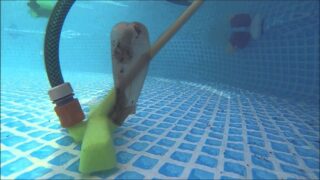
Contamination of the artificial pond is inevitable. The wind brings debris and fine dust, leaves, flowers and branches fall from trees and bushes into the water. Bathers leave hair, cosmetics, skin flakes in the water. Microparticles gradually settle to the bottom and walls of the pool, forming a dense, poorly water-soluble dirty film.
It looks unattractive and is the reason for the blooming of water, the multiplication of harmful bacteria. Periodically, the bowl of the reservoir must be freed from the accumulated dirt. For this, it is better to use a special device - a water vacuum cleaner.
The filter in the supply pipe does not protect the water from the ingress of dirt from the air.
The device and principle of operation of the pool vacuum cleaner
The scheme of work for vacuum cleaners of different types is the same.
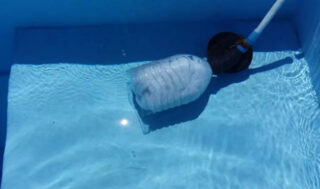
Water a do-it-yourself pond vacuum cleaner is usually a hand-held device. You can also find ready-made ones. The construction is simple. This is a plastic or aluminum rod, on which a nylon or PVC hose for pumping water, a brush and a garbage bag made of mosquito net or gauze are fixed. The cleaner lowers the device to the bottom or wall so that the bristles touch the surface and pulls on the piston. Water, together with debris and mud film, is sucked in through the hose and passed through the filter. Clean water is discharged into the pool, and debris and dirt accumulates in the bag.
Such a design is independent of electricity, compact, rather light, but some preparation is required to work with it, since the piston will have to be pushed manually only by physical effort.
Vacuum works on a similar principle, but the cleaner does not have to make an effort. Water circulation is provided by a pump. The suction power can be adjusted, as well as the tightness of the joint with the wall. Such a vacuum cleaner can collect dirt in a container or transfer it to a filtration system.
Distinguish between semi-automatic and automatic vacuum cleaners. The former are directly controlled: the vacuum cleaner, at least, needs to be held in hand. The machines are programmed and controlled from the remote control. Robots are much more expensive, but they clean the pool themselves.
It is not difficult to make a manual version at home. It is enough to choose the right parts of the appropriate size. The brushes can be used from a regular vacuum cleaner. The model with an electric motor and a pump is more difficult to assemble. Such work requires some knowledge of electrical engineering and skill.
Pros and cons of a water device
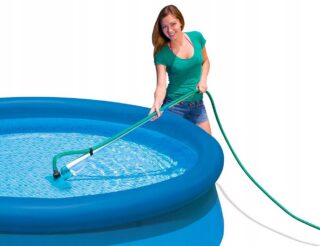
The advantages of water vacuum cleaners are evident in medium to large sized pools.
- Less labor-intensive - no need to drain the entire mass of water, and then refill. If a filtration system is installed, it takes a long time to empty the pool. But if there is a vacuum cleaner, there is no need for emptying.
- Speed - the device allows you to immediately get rid of debris brought by, for example, a strong wind during a thunderstorm. Moreover, you do not need to drain the water for this.
- Even a large body of water can be cleaned in 1.5-2 hours.
- Cleaning with a brush does not damage the finish. Even if a polyethylene bowl was used for the pool or the bottom is a layer of waterproofing film, cleaning is allowed.
- The most important plus is that modern mechanical cleaning allows you to reduce the use of chemical protective equipment and for disinfection. This significantly reduces the cost of maintaining the reservoir.
The vacuum cleaner has only one drawback: an invented device is quite expensive. However, it can be replaced with a manual option.
What tools and materials will be required
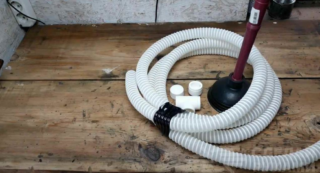
To make an underwater vacuum cleaner, you need the simplest materials:
- polypropylene pipe - nylon is allowed;
- sealing gum;
- corrugated hose - worth buying with a large margin;
- vacuum cleaner brush or any other attachment;
- pump;
- tees and other connecting elements;
- scissors, file or sandpaper;
- parting for soldering;
- waterproof glue.
Home craftsmen use the most unexpected improvised means to make the device: a plunger, a shower hose, car wipers, a landing net.
How to choose a material for manufacturing
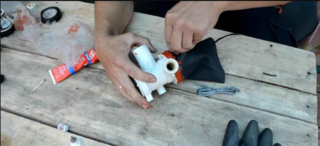
The simplest model is assembled from a 2 liter bottle or a 5–10 liter container. A hose for suction of debris is installed on the neck. A filter is mounted inside the case. At the bottom of the device, a motor from a child's toy or tape recorder is fixed. The fan blades are cut out of tin, the edges are cleaned and the impeller is mounted on the motor shaft.
Such a vacuum cleaner can work both from the mains and on batteries. However, the capacity of the model is low and only suitable for small ponds.
If there is no ready-made filter, it is replaced with a homemade design. For example, a garbage bag is sewn from a water-permeable fabric, such as tulle and organza, and inserted into a receiving tube. Then a filter is mounted from a plumbing adapter and sponges. The edge of the adapter is sawn off at an angle and processed with sandpaper, then sponges are glued to the edges. A gap is left between them for water to enter. It is better to protect foam rubber with a piece of linoleum. This design does not allow large debris, insects, leaves to pass through, and small debris is already retained in the bag itself.
A hand-held electric vacuum cleaner is mounted on a rod. Better to buy a telescopic structure.
Vacuum cleaner from submersible pump
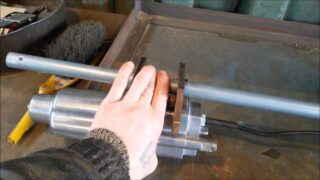
This option is much more convenient to use when cleaning the bottom of a complex configuration. For him, they take a submersible pump capable of working under the water column. The step-by-step instructions are simple.
- A tee is assembled from a polypropylene pipe. The pipes are connected by soldering.
- Caps are put on the end of the segments.
- A longitudinal hole is cut out from the bottom of the pipe and the edges are cleaned. A handle is welded to the top of the tee.
- In the center, the plunger extends the through hole and a tube is inserted into it. Connect a plunger with a corrugated pipe.
- The structure is connected to the inlet valve on the pump.
Garbage in such a vacuum cleaner remains on the filter, so the latter needs to be cleaned more often.
Operating rules
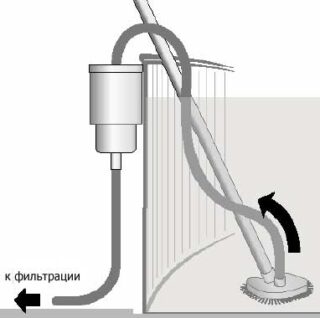
When working with an electric vacuum cleaner, you must follow the safety rules:
- turn on only when there are no people in the pool;
- connect only through an RCD;
- if the electrical cable is damaged, replace it immediately.
The general requirements must also be met: empty the bag, clean the filter.
Instructions for collecting garbage from the bottom of the pool:
- A brush is placed on the handle and the length of the handle or rod is adjusted.
- Lower the nozzle to the bottom.
- Fill the hose with water. To do this, the hose is slowly lowered into the pool.
- The other end of the hose is connected to the skimmer. If the vacuum cleaner has its own filter, this step is not performed.
- Turn on the pump and start cleaning.
A vacuum cleaner for a reservoir is a convenient and practical device that allows you to quickly vacuum the bowl of a reservoir. It is recommended to purchase or make a device if a medium or large pool is being built in the country.








